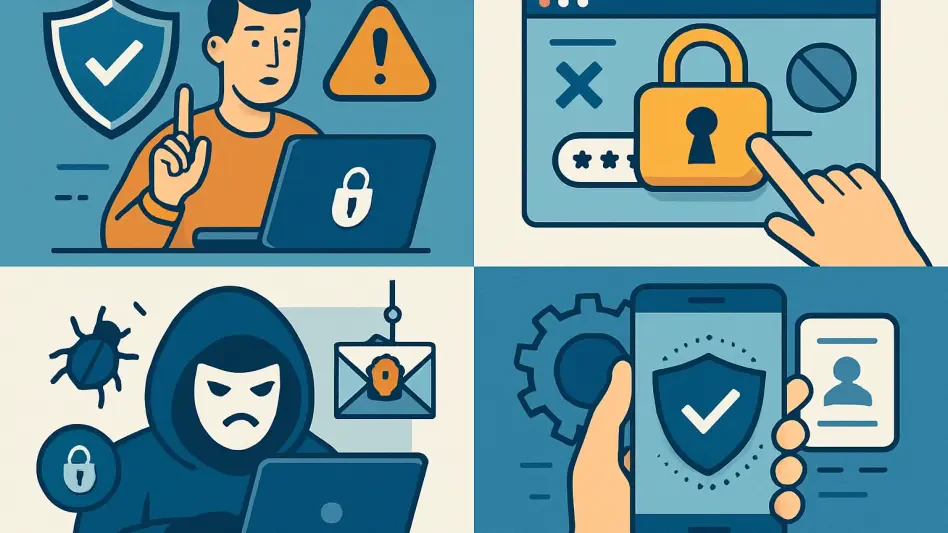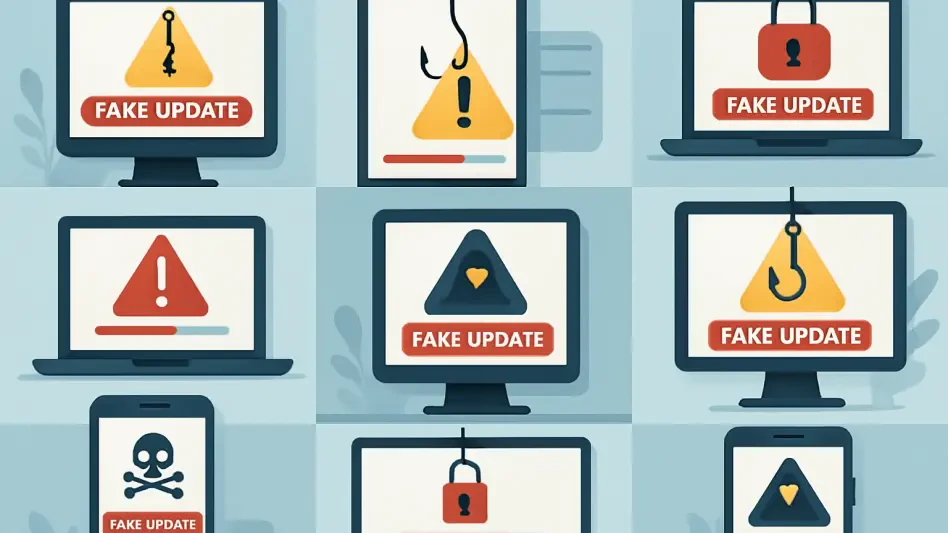Cyber threats continue to evolve in sophistication, leveraging emotional manipulation to exploit human vulnerabilities, causing substantial financial losses and data breaches. Despite advancements in digital security, cybercriminals have adapted, using advanced techniques to deceive individuals and organizations. This article serves as an essential guide to understanding and safeguarding against these pervasive social engineering scams.
The Rise of Cyber Scams
Escalating Economic Impact
The monetary losses resulting from cyber scams have skyrocketed in recent years. According to the Federal Trade Commission, U.S. consumers lost more than $12.5 billion to fraud in 2024. This marks a 25% increase from the previous year, highlighting the growing economic impact of cyber scams. These figures underscore the necessity for heightened awareness and robust security protocols among individuals and organizations alike.
The financial impact is particularly concerning in an era where digital transactions have become commonplace. Businesses and consumers must understand that while digital innovation offers convenience, it also introduces unprecedented risks. The staggering loss figures also illustrate how adept cybercriminals have become at exploiting system and human vulnerabilities despite ongoing advancements in cybersecurity technology.
Prevalence of Common Scams
Among the various types of scams, investment scams led to the highest financial losses with $5.7 million reported. Imposter scams remained the most commonly reported type, showcasing the widespread nature of these deceptive practices. Email remains the primary medium for these scams, followed by phone calls and text messages. In particular, these communications often masquerade as legitimate notifications, lulling recipients into a false sense of security.
Many victims of these scams tend to neglect intricate verification processes due to the seemingly authentic presentation of scam communications. The prevalence of these scams highlights the importance of remaining cautious and critically assessing any unsolicited communication, regardless of how credible it might seem. Technologies that facilitate these frauds continue to evolve, so constant vigilance and informed skepticism are necessary for mitigation.
Understanding Social Engineering
Emotional Manipulation Tactics
Social engineering scams leverage emotions such as fear, curiosity, sympathy, and pride to manipulate victims. These scams aim to steal money or data, install malware, cause system malfunctions, or even manipulate financial markets or elections. Understanding these emotional manipulation tactics is crucial in recognizing and avoiding these scams. Victims often find themselves unaware that their responses were manipulated, making this a particularly insidious form of cyber threat.
For instance, fraudsters might send emails that create a sense of urgency or fear, coercing recipients to act impulsively. Recognizing such tactics, understanding the common emotional triggers cybercriminals exploit, and developing a protocol for responding to such situations can significantly reduce the risk of falling victim to social engineering. Raising awareness about these methods is vital for fostering resilience against such scams.
Notable Example of Advanced Scams
A compelling incident involves a multinational financial company in Hong Kong. An employee was deceived into transferring $25.6 million to a fraudulent account through a deepfake video conference. This underscores the advanced and convincing nature of modern scams, even fooling experienced individuals. The scammers used generative AI to create a video that convincingly mimicked colleagues, including the company’s CFO.
This instance highlights the sophistication with which cybercriminals orchestrate these scams. Tools such as deepfake technology and generative AI facilitate the creation of incredibly realistic and seemingly authentic interactions. This level of deception necessitates enhanced verification protocols and developing an awareness of the potential for sophisticated fraud. Organizations must stay ahead of these advanced tactics to effectively safeguard their assets and information.
Types of Social Engineering Scams
Phishing and Its Variants
Phishing often involves sending fraudulent emails designed to lure recipients into revealing confidential information or transferring money. Warning signs of phishing emails typically include messages that instill fear or urgency, prompting immediate action without giving individuals time to think clearly. Recipients are often asked to click on a link or download an attachment, leading to unintended consequences such as computer viruses or malware.
Spear Phishing represents a more targeted form of phishing where the scammer has done prior research to personalize their approach, often addressing the victim by name or pretending to represent a familiar company or person. This targeted approach increases the likelihood of success, as it diminishes the recipient’s suspicion. Whaling is a form of phishing aimed at high-ranking individuals within an organization, such as executives, in an effort to steal substantial amounts of money or sensitive information. These high-value targets often have access to proprietary information and significant financial resources, making a successful whaling attempt particularly damaging.
Phone and Messaging Scams
Vishing involves using phone calls or voicemail messages to execute phishing scams. Scammers might pose as bank representatives, government officials, or technical support staff to extract confidential information from their victims. Vishing often plays on the victim’s sense of urgency and fear, leveraging the immediacy of voice communication to prompt hasty decisions. Ensuring awareness about these tactics is essential for reducing the effectiveness of vishing.
Smishing, akin to phishing, is conducted via SMS (text) messaging. Victims receive messages that prompt them to click on malicious links or provide personal information. Quishing is a newer form of email scam where cybercriminals use QR codes to direct victims to malicious websites. The seemingly benign nature of QR codes makes quishing particularly dangerous, as it plays on the trust placed in what appears to be advanced and secure technology. Recognizing these tactics involves scrutinizing unexpected messages and being cautious about following unsolicited instructions.
Innovative and Social Media Scams
Zishing takes place on platforms like Zoom, using deepfake technology within videoconferencing to deceive victims. The widespread adoption of video conferencing tools, especially in a post-pandemic world, has made this a viable method for cybercriminals. Users must be cautious about verifying contacts and the authenticity of video communications to prevent falling victim to zishing.
Angler Phishing targets social media users who have posted complaints or negative feedback about a service or company. Scammers pose as customer service representatives to trick users into providing personal information. This method highlights the need for vigilance when interacting with supposed customer service agents on social media. Users should validate the identity of the respondents and avoid providing sensitive information through these channels.
Cybercriminal Tactics and Defense Measures
Email Spoofing and Business Email Compromise
Email Spoofing involves altering the sender’s email address to make it appear legitimate, thus deceiving the recipient. This tactic often employs nearly identical email addresses that evade detection. This subtle deception makes it essential for recipients to closely verify sender details and question unexpected or out-of-context communications.
Business Email Compromise (BEC) scams typically involve cybercriminals hacking into corporate email systems and sending emails that seem to come from senior management. These emails often aim to extract financial information or authorize fraudulent transactions. The trust placed in seemingly legitimate senior management emails makes BEC particularly effective. Implementation of measures such as multi-factor authentication and stringent internal verification processes can mitigate these risks.
Scareware and Romance Scams
Scareware tactics often frighten users into downloading malware or purchasing fake software under the guise of solving urgent security issues. Pop-ups or alarming messages play on the user’s fear to prompt immediate action, often resulting in the installation of malicious software. Awareness of these tactics and skepticism about unsolicited security alerts are critical in combating scareware.
Romance or Honeypot Scams involve creating fake profiles on dating apps or social media to build artificial romantic relationships. Scammers exploit the emotional investment of their victims to extract financial gain or personal information. These scams highlight the importance of verifying the identity of online connections and avoiding sharing sensitive personal details prematurely. Awareness and caution while cultivating online relationships are vital in preventing these emotionally manipulative scams.
Steps to Protect Against Cyber Threats
Immediate Actions if Victimized
Upon falling victim to a scam, it is crucial to disconnect from the internet, perform system scans with trusted security software, and change compromised usernames and passwords. Contacting financial institutions and credit bureaus is also recommended. Immediate action can help curb the damage and prevent further exploitation.
It is also advisable to report the incident to authorities such as the Federal Trade Commission and notify friends and colleagues to prevent additional victimization. Sharing experiences and being open about these incidents can foster a community-wide awareness, aiding in prevention and early detection of similar scams in the future.
Preventive Measures and Awareness
Cyber threats continue to grow in complexity, employing emotional manipulation to take advantage of human weaknesses. This results in significant financial losses and data breaches. Despite progress in digital security, cybercriminals have evolved, utilizing sophisticated techniques to deceive both individuals and organizations. These cyber adversaries skillfully exploit trust, making them even more dangerous. This article aims to provide a comprehensive guide to understanding and protecting against these widespread social engineering tactics. By recognizing these sophisticated scams, individuals and businesses can better equip themselves to prevent falling victim to these attacks. The need for heightened awareness and proactive measures is paramount in today’s digital landscape, making this guide an invaluable resource for anyone looking to bolster their defenses against the ever-evolving threat of cybercrime. Understanding these tactics and implementing preventive strategies are crucial steps in mitigating the risks associated with social engineering schemes, ensuring both personal and organizational security.







